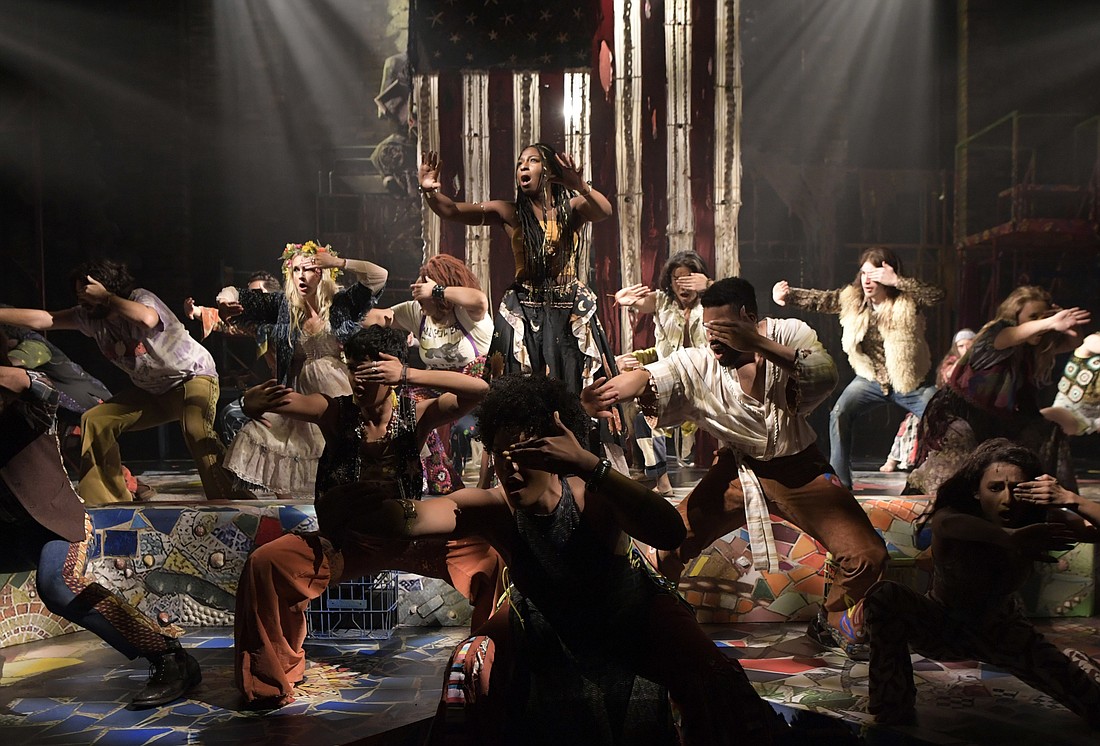- April 29, 2025
-
-
Loading

Loading

The year was 1968. Colonies of longhaired hippies were popping up like mushrooms across America. Legitimate musical theater was not immune. Because that was the year “Hair: The American Tribal Love-Rock Musical” revolutionized Broadway. Gerome Ragni and James Rado wrote the book and lyrics; Galt MacDermot composed the music. Their musical perfectly captured the counterculture’s utopian dream. That dream was trendy at the time. But trends change.
The Age of Aquarius never dawned. As Elvis Costello and Nick Lowe pointed out, the quest for “peace, love and understanding” seemed like a joke to many in 1974. But cynicism’s just another style. And that changed, too …
Like Sgt. Pepper’s Lonely Hearts club band, this musical’s been going in and out of style over the years. Our grim decade seems ripe for revived hippy happiness. “Hair” is back — and alive and kicking on the Asolo Rep stage.
The musical’s songs are great. Its story … not so much. The narrative (such as it is) revolves around a “Tribe” of hippies squatting in parks and abandoned buildings in New York City in 1968. To the extent “Hair” has a central character, that’s Claude (Damon J. Gillespie). He’s a New Jersey hippy who pretends he’s from England. His number comes up in the draft lottery. The members of the Tribe (renamed the “Pack,” in this version) figure Vietnam’s a one-way ticket for a non-violent peacenik like Claude. But they can’t quite figure out how to sneak him into Canada.
The other characters include Berger (Kaleb Wells), the Pack’s putative leader, a charismatic anti-authority figure. The Pack pretty much worships him. Berger shares their high opinion of himself. Jeannie (Becca Andrews) is madly in love with Claude — though this flower child’s blossoming in a family way, thanks to a one-night stand with a meth aficionado (not Claude). Woof (Jonathan Fleites) is the human embodiment of love both physical and metaphysical. Hud (Nora Schell) lends her commanding voice to the emerging Black Power movement. Sheila (Olivia Kaufmann) is deeply committed to the old New Left. (Thanks to the emerging feminist movement, she’s waking up to the male chauvinist power trips of some of the New Left’s leaders.) Garrick Sigl and Ethan Saviet are both hilarious as square couple doing a walking tour of counterculture hangouts in New York City.
Director/choreographer Josh Rhodes and assistant director Emily Abrams take a magical realist approach to these characters’ lives. While the musical’s set in 1968, they’re not trying to create a spot-on-historical recreation. “Hair” was timely in its infancy. Rhodes and Abrams are aiming for timeless. They’ve airbrushed away the macho attitudes of the musical’s characters (and creators). The Asolo Rep’s creative team also reimagined the musical’s look.
Where this musical’s original production (and most revivals) unfolded under the sun, this transpires in an interior space. (Imagine a mash-up of cast-off urban debris, with a giant eyeball at the top straight out of a Rick Griffin rock concert poster.) Anna Louizos created this broke-down palace. Her vast set reminds me of the Lost Boys’ hideout in “Peter Pan.” (In this case, the Lost People of all Descriptions.) It’s stunning work. And Louizos deserves a heaping helping of kudos for it.
The Pack’s rags and feathers are flamboyant and otherworldly — and not exactly what the kids were wearing back then. Dede Ayite deserves her own share of kudos for creating this wearable rainbow of invention.
The dancing in most “Hair” revivals typically resembles a cut-away segment in “Laugh-In.” Here, it’s more lugubrious. Rhodes and co-choreographer Ishita Mili aren’t going for bump-and-grind. Their choreography externalizes The Pack’s psychedelic (and chemically enhanced) state of mind. Mili also draws on her training in classical Indian dance to evoke a sense of the sacred.
It’s a fun show. I enjoyed the trip at the time — though I felt like something was missing. After the show, I found out I was right.
The original production of “Hair” was two hours and 10 minutes with one intermission. The Asolo Rep production condensed it to an uninterrupted 90 minutes. That’s a loss of 40 minutes. So what did they cut?
Two politically incorrect songs — and much dialogue. The story was thin to begin with. This cut it off at the knees.
The deleted dialogue carried the heavy freight of individual characterization. These chopped chats also painted a picture of this Tribe’s group dynamic. (This is “The American Tribal Love-Rock Musical,” after all.) Before the cuts, characters spent a lot of time talking to each other. Afterwards, they rarely do. Now they mostly soliloquize about themselves. Or merge into the anonymous chorus of actors.
When the characters talk, they seem self-absorbed. It’s not that big of a problem. Because they’re singing for most of the time. This musical’s greatest strength is music. The story of “Hair” may be thin. But its songs are heavyweight contenders.
Cutting a big chunk of the spoken-word script makes this production feel like a musical revue at times. That’s not such a bad thing. The material’s damn good — and spawned a range of hits at the time, (“The Age of Aquarius,” “Hair,” “How Can People Be So Heartless,” and “Good Morning, Starshine,” to name a few.) The actors here are as young as their characters. They put their hearts into the music. They feel it. You’d have to be heartless not to feel it, too.
“Hair” ends on a tragic note. But the closing song is an upbeat powerhouse. “Let the Sunshine In” is the name of that tune. It was a good idea then. It’s still a good idea.
What’s so funny about peace love and understanding?
Nothing at all.